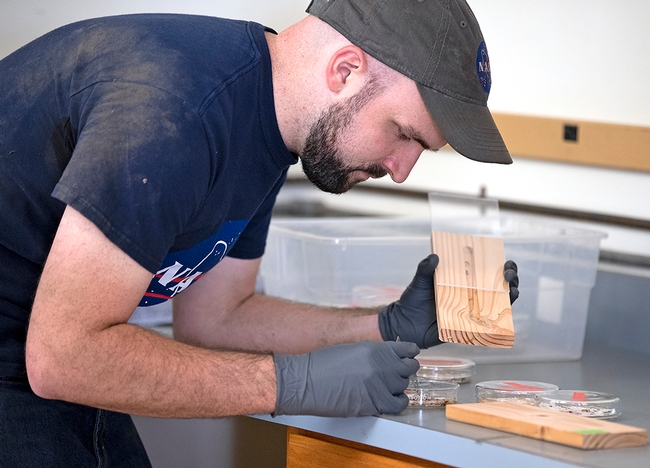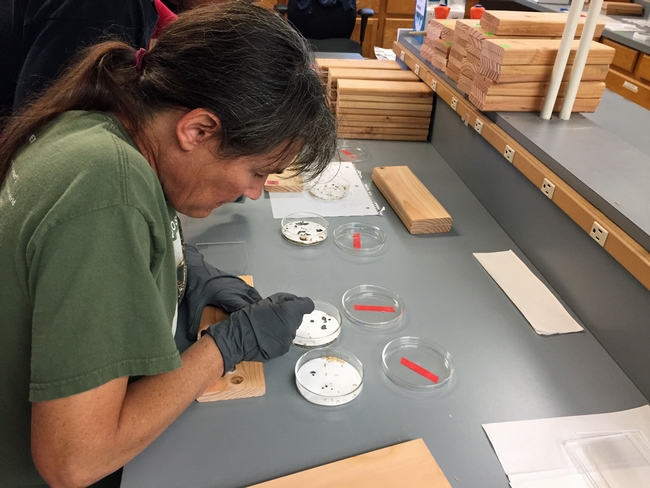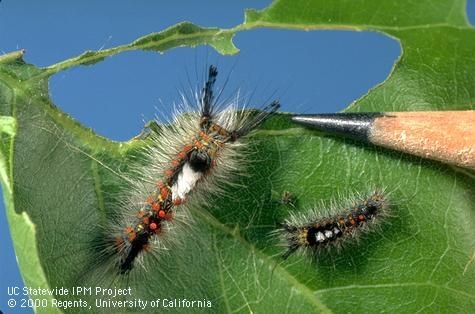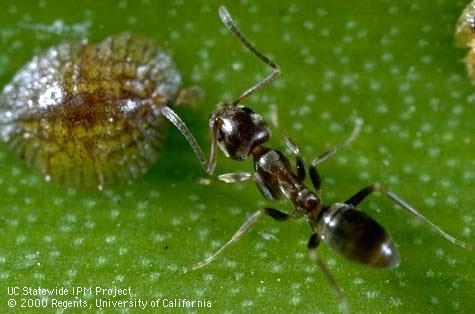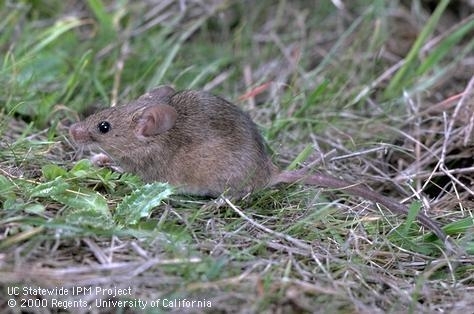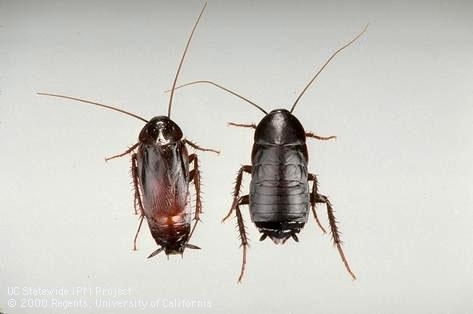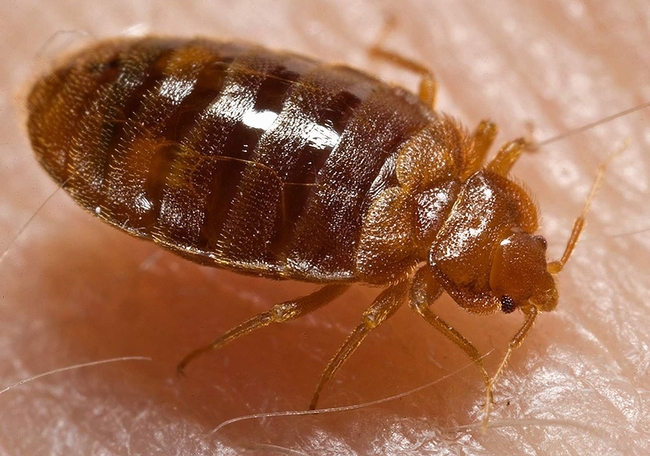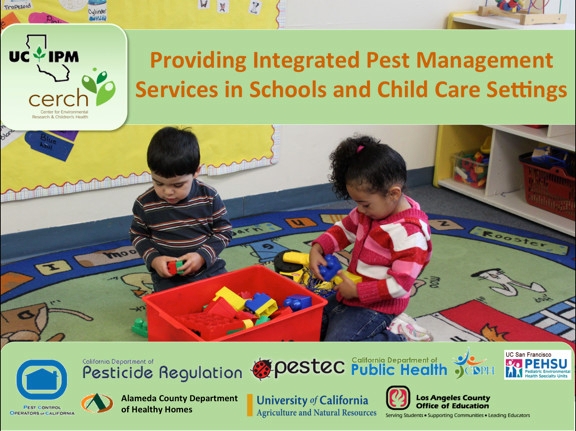Posts Tagged: Andrew Sutherland
Termites can’t hide from heat and essential oils, finds UCCE study
Termites can eat you out of house and home by chewing through wood and weakening the structure. The results of a new termite study led by entomologists at UC Riverside may enable homeowners to rid their homes of termites with a safer, effective pest control approach.
“Combining a volatile essential oil with heat might reduce callbacks for pest management professionals and potentially lead to lower risk of heat damage to things in the homes,” said Dong-Hwan Choe, UC Cooperative Extension specialist in the Department of Entomology at UC Riverside.
The conventional method of exterminating termites requires residents to vacate the house while pest control professionals tent the structure then pump in toxic chemicals to kill the termites. While insecticides are effective at killing termites, urban pest managers are under pressure from regulators and residents to find alternatives that won't harm people, pets or the environment.
To rid structures of termites without using chemicals, pest control professionals heat the air inside structures to lethal temperatures. However, termites can survive in hard-to-heat areas such as in wood positioned against concrete foundation walls. In a recent study, Choe found adding essential oils to heat treatments can kill termites insulated from the heat.
“You need some kind of insecticide to kill the termites in those locations that are hard to heat,” said Daniel Perry, who conducted the study as a UC Riverside graduate student with Choe.
“By using an essential oil, which is toxic to termites, we can kill them without really any risk to humans or other animals that live in the house.”
The western drywood termite, Incisitermes minor (Hagen), is a common structural pest in the United States native to California, from the border with Mexico to Central California and inland to the Sierra Nevada Mountains.
“We tested several insecticidal essential oils on individual western drywood termites and found that methyl salicylate, or wintergreen oil, killed them the fastest,” said Choe.
Wintergreen oil kills termites, but it doesn't hurt people or their pets. Although pest control professionals commonly use orange oil for localized drywood termite treatments, wintergreen oil has about twice the flash point so it's safer to use with the heat treatment, Perry said.
To test the synergy of the volatile essential oil and heat, the research team placed wood blocks infested with 20 drywood termites each in Villa Termiti, a small wooden structure built for pest management research at the UC Berkeley Richmond Field Station. They applied 160microliters (about 16 drops) of wintergreen oil to some infested wood blocks (the treatment) and no wintergreen oil to other infested blocks (the untreated control), then used propane heaters to heat the house to between 134 degrees and 146 degrees Fahrenheit for 140 minutes. After seven days, they found that 92% to 100% of the drywood termites were dead when treated. In contrast, in blocks without the wintergreen oil, only 36% to 44% of the termites died in the same time period when treated within areas near the concrete foundation wall. Incorporation of the essential oil substantially increased the control efficacy for this area near the foundation, resulting in more than 90% mortality.
Lethal temperatures and essential oils will kill termites at all life stages, but the scientists used immature termites at the pseudergate (worker) stage. The wingless, pale pseudergates do most of the work for the colony, excavating tunnels and chewing up food for the other termites to eat.
“If you can kill all of the pseudergates, then the rest of the colony will likely collapse,” said Perry, who went to work for Procter & Gamble after finishing this project and his master's degree at UC Riverside.
“The most common treatment is fumigation and that requires three or four days during which the structure has to be vacated,” said Perry. "With the heat treatments, all you have to do is heat up the structure until the wood inside gets to the temperature that will kill the termites, hold the lethal temperature for a few hours, and then let the house cool off. You only have to be out of the house for maybe six hours, so it's a lot more convenient.”
Andrew Sutherland, UC Cooperative Extension integrated pest management advisor for the Bay Area, offers training for pest management professionals. He is encouraged by the results.
Sutherland said, “It means that folks will be able to heat effectively at lower target temperatures and lower durations, so it's less cost for everybody, and probably less time for everybody. It's a way to really synergize the heat treatment and no fumigant gas is released to the atmosphere.”
“Volatile Essential Oils Can Be Used to Improve the Efficacy of Heat Treatments Targeting the Western Drywood Termite: Evidence from Simulated Whole House Heat Treatment Trials” was published in the October 2020 edition of Journal of Economic Entomology.
ANR in the news April 19-30
CDFA awards grant for Proactive IPM program
(Morning Ag Clips) April 30
The California Department of Food and Agriculture has awarded funding for one project in the initial funding cycle for the Proactive Integrated Pest Management (IPM) Solutions grant program. The project, titled “Proactive Biological Control of Spotted Lantern Fly, Lycorma delicatula (Hemiptera: Fulgoridae)” was awarded $543,936.
The three-year project will develop biological control agents for spotted lantern fly, an invasive pest that has not yet arrived in California but is spreading rapidly across the eastern US. This pest has the potential to affect many high-value California crops including grapes, walnuts, avocados, and pistachios. The project will piggyback on work that is already being conducted on the pest in the eastern US and abroad. Project leads are Dr. Mark Hoddle (UC Riverside) and Dr. Kent Daane (UC Berkeley). The biological control agent is a small (3 mm) stingless wasp, native to China, that parasitizes the eggs of the spotted lantern fly.
https://www.morningagclips.com/cdfa-awards-grant-for-proactive-ipm-program
Learn about sheep, shearing, and more at Barn to Yarn in Hopland this week
(MendoVoice) April 30
If you've ever wondered how a sheep's wool becomes a sweater, you might want to check out the "Barn to Yarn" event in Hopland this weekend. This popular springtime event will return to the University of California Hopland Research and Extension Center this Saturday, May 4.
The Barn to Yarn event will feature farmers and ranches, shearers, spinners, weavers, and knitters, and other local experts involved in the Northern California sheep industry. There will educational activities, presentations, workshops, take-home craft activities, and more for all ages.
Moth caterpillars are back for a rare second bite in the Bay Area
(Mercury News) Cat Ferguson, April 29
…Andrew Sutherland, University of California Cooperative Extension's urban integrated pest management adviser for the Bay Area, recommends a simple preventive measure: reach for the hose.
Right after the bugs have hatched, “use pressure washers to push the larvae off the trees before they start wandering around,” he said. “In the late summer and fall, if you've got egg masses, you can wash them off and you won't have an issue next year on that tree.”
Bay Area pest control and horticulture experts say most caterpillar calls come from Santa Clara and southern San Mateo counties, which Sutherland linked to warm weather and high densities of host plants — the caterpillars are particularly fond of oak and fruit trees. Sutherland said he doesn't field nearly as many calls from the East Bay.
https://www.mercurynews.com/2019/04/29/san-jose-moth-boom/
Hopland Research Center holds BioBlitz for Mendocino County students
(Ukiah Daily Journal) Curtis Driscoll, April 26
The Hopland Research and Extension Center held its annual “BioBlitz” on Friday for over 200 students from across Mendocino County, giving them a chance to explore their interest in science by finding new species at the Hopland Research Site.
The BioBlitz went on at the same time as the 2019 City Nature Challenge, an international event where people find and document plants and wildlife in cities across the globe. Although students in Mendocino County couldn't participate in the national event, the Hopland Research Center decided to have the BioBlitz as a way to allow students to explore nature in Mendocino County.
…Experts also helped the students learn more about the area in Mendocino County and the many kinds of unique species that are in the county. Anna Holmquist, an arachnologist from UC Berkeley, entomology students from UC Berkeley, and California Naturalists, people who have gone through a UC naturalist training program, were all available throughout the day to help students and guide them as they made different discoveries.
“We will be looking for species with them and searching and trying to add to the list, but there will be a bit more depth to it with the kids actually trying to build on their understand of our Mendocino habitats,” said Hopland Research Center Community Educator Hannah Bird.
Have the Tough Conversations: Koopmann Family Ranch Transfer
(Capital Press) Ashley Rood, April 26
… The next generation of Koopmanns, Carissa and Clayton, are well-poised to continue the family legacy of conservation and ranching. Both are building up their own cow herds on leased land while, as partners in the family LCC, they help make the big decisions. They also have full-time agriculture jobs off the ranch focused on grazing. Clayton is the range manager for the local water utility, the SFPUC, and has a grazing management consulting business. Carissa is a livestock and natural resources advisor for University of California Cooperative Extension in Siskiyou County. Both Carissa and Clayton emphasize how hard it is to make a living ranching alone, even with all the advantages of the family ranch. But getting out on the land, despite the hard work, is a place of relaxation for both of them.
For others considering succession planning, Carissa says, “Get started early and don't ever make assumptions. It's vital to know what everybody truly wants. Ultimately, the end goal that is that you're still a family, regardless of what happens.”
Fresh, local and sustainable advice
(Marin Independent Journal) Jane Scurich, April 26
Ah, spring! Time to visit the local farmers market for tender locally grown asparagus, luscious spring peas and great gardening advice. Wait — what's that last item — advice? Yes — and it's free!
Knowledgeable, UC-trained volunteers in the University of California Marin Master Gardener program officially open their market advice tables in May to provide research-based information on horticulture and sustainable gardening practices to Marin residents.
https://www.marinij.com/2019/04/26/fresh-local-and-sustainable-advice/
Love science? Free app allows you to assist in research!
(ABC10) Monica Woods, April 25
…In the words of Laci Gerhart-Barley, iNaturalist is "Instagram for biology and nature enthusiasts." The professor with the biological services department at the University of California, Davis, is even incorporating it into her classroom.
… Each year iNaturalist users participate in a "competition" to see what region can upload the most photos in the matter of a few days. The City Nature Challenge started as a competition between the California Academy of Sciences in San Francisco and the Los Angeles County Natural History Museum and gradually grew to include regions all over the world.
The Sacramento region is getting on board for the first time in 2019. [Sarah Angulo, community education specialist for the California Naturalist Program, is helping organize the challenge.]
The City Nature Challenge Sacramento will take place from Friday, April 26 to Monday, April 29.
UC Extension head updates supervisors on programs and leaders
(Plumas News) Victoria Metcalf, April 24
The face of the Farm Advisor's office is changing.
Plumas and Sierra county Farm Advisor Director David Lile was before the Plumas County Board of Supervisors April 9, explaining just how much his staff has changed.
… Holding up a copy of the local University of California Agriculture and Natural Resources annual report for last year, Lile said, It's “easy to look at with plenty of pictures.”
…Lile then introduced Ryan Tompkins as the new forestry advisor. He replaces longtime representative Mike DeLasaux who retired in 2018.
…Natural resources and livestock liaison with local ranchers was introduced next. That's Tracy Scholr [Schohr].
…Most 4-H members and their parents already know 4-H Program Representative Kari O'Reilly.
… Tom Getts was also introduced as the technical assistance for Plumas and Sierra farmers and Susanville area land managers.
… And Barbara Goulet, as administrative assistant, provides support to the staff, but also works with local Master Gardener volunteers and 4-H volunteers, according to Lile.
http://www.plumasnews.com/uc-extension-head-updates-supervisors-on-programs-and-leaders/
Can California get cows to burp less methane?
(NBC News) April 24
California is now requiring the beef and dairy industry to reduce its greenhouse gas emissions. Some scientists are testing and growing a red algae seaweed that can reduce methane from cow burps.
https://www.nbcnews.com/leftfield/video/can-california-get-cows-to-burp-less-methane-1506967107599
How to Control Thrips in Blueberries
(California Fresh Fruit) Matthew Malcolm, April 24
Citrus thrips have been a major nuisance for California blueberry growers, but how do you keep them under control and when should you apply crop protection materials? Is there an organic treatment available? Watch this brief interview UC Cooperative Extension Farm Advisor David Haviland as he answers all these questions. Read more about blueberry pest management in California Fresh Fruit Magazine.
https://calfreshfruit.com/2019/04/24/how-to-control-thrips-in-blueberries/
UC: Older vineyards can be modified for mechanization
(Ag Alert) April 24
Saying they have proven that older vineyards can be converted to mechanization, University of California Cooperative Extension specialists say winegrape growers in the San Joaquin Valley do not have to replant vineyards if they want to switch to mechanical pruning.
Growers who want to make the switch can retrain the vines to make the transition, without losing fruit yield or quality, according to a UCCE study.
UCCE specialist Kaan Kurtural said the study found that "growers do not have to plant a new vineyard to mechanize their operations."
"We have proven beyond a doubt that an older vineyard can be converted to mechanization," he said.
There is no loss in yield during conversion, Kurtural said, "and post-conversion yield is better and fruit quality is equivalent to or better than hand-managed vines."
http://agalert.com/story/?id=12932
No replanting needed for mechanical pruning
(Farm Press) Tim Hearden, April 24
University of California (UC) researcher Kaan Kurtural has gained recognition in recent years for automating a vineyard operation in the Napa Valley, which was planted at a density conducive to the practice.
Now Kurtural and other UC Cooperative Extension scientists are applying their knowledge in the San Joaquin Valley, where they say growers who wish to switch from hand to mechanical pruning to save labor won't have to replant to do so.
https://www.farmprogress.com/grapes/no-replanting-needed-mechanical-pruning
Wet winter in Sonoma County may have helped spread virulent oak disease
(Press Democrat) Derek Moore, April 24
Now that the North Coast is finally drying out from an unusually wet winter, concern is growing over the potential rapid spread of sudden oak disease, renewing calls for the public's help tracking the deadly forest pathogen.
“Now is when we might expect the pathogen to take off a bit,” said Kerry Wininger, a UC Cooperative Extension staffer in Santa Rosa.
Wininger is a local organizer of annual sudden oak death surveys known as the SOD Blitz. This year's survey occurs from April 25 to 28 across Sonoma and Mendocino counties. Organizers are hoping for a good turnout of volunteers, who will become educated spotters and collectors to help scientists slow the disease's spread.
https://www.sonomanews.com/lifestyle/9531662-181/wet-winter-in-sonoma-county
Young chefs: Local students prepare and taste international meals at fourth annual Culinary Academy
(Lompoc Record) Lorenzo J. Reyna, April 24
Twenty-one elementary school students spent part of their spring break learning to cook various international recipes inside Rice Elementary School's cafeteria Wednesday.
The fifth- and sixth-graders from 4-H Student Nutrition Advisory Council Clubs took part in the fourth annual Culinary Academy, spearheaded by six adults from UC CalFresh Healthy Living.
…Janelle Hansen helps oversee the 4-H SNAC Clubs as supervisor of the Santa Barbara and San Luis Obispo group.
She said Wednesday's five-hour event from 1 to 6 p.m. was much more than just students learning how to create various dishes.
“The hope is that they will learn the life skill of healthy living and nutrition — and that's really one of our goals,” Hansen said as the students were preparing their meals.
Close to home or farther afield, visit California's native plants and gardens
(Los Altos Online) Tanya Kucak, April 24
If you're in the mood for some road trips, immerse yourself in an atmosphere of beautiful plants and enthusiastic people by attending the Going Native Garden Tour, now in its 17th year.
Sponsored by the California Native Plant Society in association with the UC Cooperative Extension Master Gardeners of Santa Clara County, the tour offers an unparalleled chance to talk with gardeners and designers, view gardens of different types and compare gardens planted a year ago to those planted a couple of decades ago. More than 50 gardens are scheduled to be open 10 a.m. to 4 p.m. May 4 and 5. Gardens in San Jose and other southern Santa Clara County cities will be open May 4, while May 5 will feature visits to northern gardens from San Mateo to Sunnyvale, including Mountain View. No Los Altos gardens will be on display this year.
https://www.losaltosonline.com/news/sections/magazine/59930-
AgriTalk: How Agriculture is Managing High-Level Issues
(Agweb.com) Ashley Davenport, April 23
Dr. Frank Mitloehner of the University of California-Davis recently was awarded the 2019 Borlaug Council for Agricultural Science and Technology (CAST) award. He talks about what that award means for him, how he started on social media, and greenhouse gas emissions.
https://www.agweb.com/mobile/article/agritalk-how-agriculture-is-managing-high-level-issues/
Mechanical Vineyard Pruning Possible Without Replanting
(AgNet West) Brian German, April 23
One of the major concerns regarding mechanical vineyard pruning is the time and cost associated with replanting a vineyard in a manner that would accommodate the process. However, a report from University of California Cooperative Extension researchers that was published in HortTechnology demonstrates that replanting is not necessary. Research conducted in Madera County found that growers can mechanize their operations by retraining vines without suffering any fruit loss or decline in quality.
“The trial actually ran for three years,” said Kaan Kurtural, UC Cooperative Extension specialist in the UC Davis Department of Viticulture and Enology. “In the end, there was like no loss in yield even during the conversion years and the quality was actually much better in the mechanically managed plants.”
http://agnetwest.com/mechanical-vineyard-pruning-without-replanting
Is a small farm or ranch your dream? The Beginning Farming Academy is for you!
(Yuba Net) April 23
Is your dream to start a small farm or ranch? Are you ready to get started on your dream? Apply for the Beginning Farming Academy offered by the University of California Cooperative Extension on April 26th and 27th, 2019. The class is held in Auburn and runs from 8 AM to 8 PM on Friday, April 26th, and from 8 AM to 5 PM on Saturday, April 27th. April 23 is the application deadline for the April class.
The Academy is an intensive 2-day introduction to starting a small commercial farm or ranch and will help prospective farmers jumpstart their operations. “Participants will learn to assess their land and resources, research markets, and analyze the potential economic viability of their operation,” says Dan Macon, Livestock and Natural Resources Advisor.
California's high-value crops, like fruits and nuts, are the ones most vulnerable to climate change
(Fast Company) Larry Buhl, April 22
Agronomy, a peer-reviewed, open access scientific journal, laid out a stark future for California agriculture, predicting it will be vastly different by the end of the century. Led by Tapan Pathak of the University of California, Merced, the research team concluded that almost all of California's crops, together valued at more than $50 billion a year, will be endangered by rising temperatures and unstable weather patterns brought by climate change. The state will face wildly fluctuating precipitation patterns, leading to severe droughts and flooding, warming temperatures, more heat waves, and shorter chill seasons. The researchers wrote that the increased rate and scale of climate change “is beyond the realm of experience for the agricultural community,” and that changes in the state's crop output “would not only translate into national food security issues, but also economic impacts that could disrupt state and national commodity systems.”
Michael previews the UCCE Annual Spring Garden Tour
(Fox 26) Stephen Hawkins, April 22
The University of California Cooperative Extension Fresno County Spring Garden Tour & Plant Sale takes place this weekend.
Michael Ikahihifo spent the morning at Garden of the Sun on Earth Day to give us a preview.
https://kmph.com/great-day/michael-in-the-mix/michael-previews-the-ucce-annual-spring-garden-tour
California Has Farmers Growing Weeds. Why? To Capture Carbon
(KQED) Lauren Sommer, April 22
…“I think there's great potential for agriculture to play a really important role,” says Kate Scow, professor of soil microbial ecology at UC Davis, of the state's climate goals. She's standing in a large wheat field at Russell Ranch, seven miles west of the campus, where the university plants crops to study sustainable agriculture.
“Soil is alive,” she says. “There's farmers that know that.”
https://www.kqed.org/science/1940561/california-has-farmers-growing-weeds-why-to-capture-carbon
California farmers try new strategy to cut carbon
https://www.npr.org/2019/04/27/717756929/california-farmers-try-new-strategy-to-cut-carbon
Mitloehner To Receive CAST Award
(Drovers) Greg Henderson, April 19
Frank Mitloehner has been chosen by the Council for Agricultural Science and Technology (CAST) as 2019 Borlaug CAST Communication Award recipient. A professor and air quality extension specialist in the Department of Animal Science at the University of California-Davis, Mitloehner is the 10th recipient of this award.
“I'm honored to be selected by CAST, an org I've long admired, and to be in the company of so many recipients who have inspired me during my career,” Mitloehner said. “Being recognized with the Borlaug CAST Communication Award is an affirmation of the importance of sharing research and academic pursuits well beyond labs, classrooms and universities.”
https://www.agweb.com/article/mitloehner-to-receive-cast-award/
California drought may be causing shifts in pest invasion behavior
Several California news stories this summer have reported increased pest problems in homes and landscapes, citing the prolonged drought as the cause. Pest control companies quoted in those stories confirm that demand for their services now is much higher than in past years.
The drought may be driving more invasions by annoying insects such as ants, but not necessarily for the reasons one might expect.
Many people are asking, “Why are there so many more pests this year than usual?”
People may just be seeing more pests, according to an urban integrated pest management (IPM) advisor with UC Division of Agriculture and Natural Resources.
“The overall abundance of pests probably hasn't changed and may even have decreased as compared to wet years,” said Andrew Sutherland, Ph.D., urban IPM advisor for the San Francisco Bay Area. “The real questions we should be asking are ‘Why are these pests appearing earlier in the year?' and ‘Why are the pests appearing all at once as opposed to throughout the year?'”
Sutherland says that landscape drydown has occurred more rapidly in recent years, so there may have been a more dramatic shift from high moisture to low moisture, prompting the nuisance pests to migrate earlier in the year and in a more concentrated manner.
“This is also the first year we've seen dramatic changes made by residents due to mandated water-use restrictions,” Sutherland said. “Areas with frequent irrigation and lush landscapes aren't available this year so nuisance pests like outdoor cockroaches, ants and crickets are migrating from dry areas to seek moisture.”
This search may lead the thirsty pests to homes, garages or landscape that they haven't visited before. The IPM advisor used oriental cockroaches as an example.
“Oriental cockroaches are highly dependent on moisture and humidity and are not normally found indoors,” said Sutherland. “Outdoors, if you have an irrigation control box, leaky hosebib or water meter box, or a French drain system, that's where you'll find them. But if this water supply has been reduced or shut off, this population you didn't even know of – that may have existed for years – may crawl under doors or into foundation cracks and move indoors in search of water.”
Sutherland advises against relying on perimeter pesticide sprays to treat for nuisance pests since these applications are effective for only a short time and therefore only represent temporary solutions. Instead, Sutherland recommends using IPM methods, such as exclusion and habitat modification, which provide more long-lasting pest invasion prevention.
To learn more about home, garden, turf and landscape pests and how to exclude them, visit the UC Integrated Pest Management website at http://www.ipm.ucanr.edu/PMG/menu.house.html. For more advice on pest problems, contact the UC Master Gardeners at a local UC Cooperative Extension office http://ucanr.edu/County_Offices.
Further reading
Cockroaches http://www.ipm.ucanr.edu/PMG/PESTNOTES/pn7467.html?src=blog18995
Ants http://www.ipm.ucanr.edu/PMG/invertebrates/links.ants.html?src=blog18995
Rodents http://www.ipm.ucanr.edu/PMG/menu.house.html#VERT?src=blog18995
UC Master Gardeners http://mg.ucanr.edu/Become_a_Master_Gardener/Counties/?src=blog18995
Excluding seasonal nuisance pests http://www.ipm.ucanr.edu/PDF/PUBS/greenbulletin.2012.feb.pdf?src=blog18995
Bedbug eradication requires tenant cooperation
To successfully eliminate bedbugs, pest management professionals say they need the cooperation of people living the pests, according to a survey conducted by UC Agriculture and Natural Resources scientists.
California's pest management pros are divided over whether they believe that some of the state's bedbug populations are resistant to insecticides, but they agree that the bugs may survive treatments by finding safe harbor in excessive clutter and personal items that tenants didn't want treated or thrown away. In addition, some settings – such as hotels, motels, college dorms and homeless shelters – may be continually reinfested.
Bedbugs are among the most challenging and expensive pests to manage. Because they are so difficult to eradicate, the job is typically left in the hands of pest management professionals, who face an increasing number of bedbug infestations in California.
UC ANR scientists are working closely with pest management professionals in the state to find ways that will make bedbug eradication easier and more likely to succeed.
Bedbugs co-evolved with humans, and feed exclusively on blood. Their preferred habitat is inside warm rooms near where humans sleep and rest. Bedbugs are drawn to the carbon dioxide that humans exhale with every breath, and they seek out a blood meal by piercing the skin of a sleeping person. A few minutes later, they scurry back to hiding places.
According to an often-referenced annual report conducted nationwide by Orkin Pest Control, the San Francisco Bay Area is No. 14 on the list of 50 cities with the most calls for help controlling the pest. Sacramento-Stockton-Modesto, now at 27, jumped 14 spaces from 2013 to 2014. Los Angeles is fourth on the list, the highest of any area in California. A Terminix report said bedbug calls in Sacramento increased 54 percent from 2012 to 2013, more than any other city in the nation.
“Increases in bedbug infestations may be partly due to changes in the way we manage household pests,” said Andrew Sutherland, the urban integrated pest management advisor for UC ANR in the Bay Area. “In the 1930s and 40s, DDT was commonly used indoors. The pesticide is very persistent and effective and controlled all indoor pests, including bedbugs, sometimes for years.”
When Sutherland was hired three years ago, he realized there was little information available about obstacles to bedbug control in California.
“Most of the information about bedbugs is from research taking place in the Midwest and the Eastern Seaboard,” he said.
UC ANR awarded funds to Sutherland and Dong-Hwan Choe, a UC ANR urban pest specialist based at UC Riverside, to collect data from those who were on the frontline in the battle against bedbugs – pest management professionals and managers of multi-unit housing facilities. The researchers later received funds from the USDA's Western IPM Center to expand the study to 13 western states.
Early results of Sutherland and Choe's surveys showed that 75 percent of pest management professionals said bedbug infestations in 2014 had increased from the previous year. Forty percent said they believed they have encountered bedbugs that were resistant to insecticides, while 60 percent said they had not.
“There was no correlation between the amount of experience the professionals had and their perception about bedbug resistance in California,” Sutherland said.
The most common way for professionals to become aware of bedbug infestation has been visual inspections after complaints by tenants. Now, prevention is on the rise, an important component of integrated pest management.
“Our objective is to manage pests below unacceptable levels with minimal negative impacts on communities and the environment,” Sutherland said. “Prevention comes before all other management practices.”
The survey found that pitfall traps (interceptors) are used at least sometimes by 40 percent of pest management respondents to monitor for the pests. Active monitors, glue board monitors and harborage or shelter monitors are also employed.
The pest management professionals reported using a wide variety of treatments against bedbugs. Insecticides were most common, used by 91 percent of respondents most of the time. Desiccants, encasements and heat were used most of the time by about half of respondents.
Housing managers had similar responses to the survey questions. Bedbug control is challenging, they reported, when tenants don't report infestations, are not willing or able to prepare their living space for treatment, when tenants bring secondhand furniture into their units, and when they fail to take information about the pest seriously.
One housing manager respondent complained about an “almost total inability to prevent infestation, or to prove its source and (having to shoulder) almost total responsibility for all concomitant costs.”
For detailed information on bedbug life cycle, detection and treatment, see the UC IPM Pest Note on bedbugs.
An initiative to manage endemic and invasive pests and diseases is part of UC Agriculture and Natural Resources Strategic Vision 2025.
Online course helps control pests, protect children
Free UC IPM course helps pest management professionals understand the Healthy Schools Act and provide IPM services to schools and child care centers
Pest management professionals can learn about the requirements of California's Healthy Schools Act by taking a free online course provided by the UC Statewide Integrated Pest Management Program (UC IPM), part of University of California Agriculture and Natural Resources (UC ANR).
To minimize children's exposure to pesticides, California requires pest control operators providing services in schools and licensed child care centers to comply with a series of laws called the Healthy Schools Act. The laws promote integrated pest management (IPM) in public K–12 schools and licensed private child care centers.
The free course Providing Integrated Pest Management Services in Schools and Child Care Settings explains what the Healthy Schools Act requires of schools, child care centers and pest control companies when managing pests in these environments.
"Taking the online course makes it easier to understand and comply with the laws," said Andrew Sutherland, UC ANR Cooperative Extension IPM advisor. "Pest management professionals can take the course at their convenience. It tells them everything they need to know about the Healthy Schools Act and IPM in order to do business with a school or child care center."
The course also includes a section on how companies can prosper by incorporating IPM principles and practices into their businesses.
"This is an opportunity for operators to take their businesses to the next level by adopting IPM practices," Sutherland said. "IPM effectively and efficiently manages pests, builds professionalism within providers, and captures value for the customer while minimizing pesticide applications, pesticide exposures and associated negative impacts on children's health, the environment and the larger community."
Licensed pest-management professionals can receive continuing education units by completing the online course: one "Rules and Regulations" and one "IPM" from the Structural Pest Control Board; and one "Laws and Regulations" and one "Other" from the Department of Pesticide Regulation.
UC Berkeley's Center for Environmental Research and Children's Health is developing a database of individuals who complete the course so that schools and child care centers can connect with pest control providers who are familiar with IPM and the Healthy Schools Act.
The training module was developed by Sutherland and collaborators at UC Berkeley and UC San Francisco, with input from California pest management professionals and child care providers.
To take the free Providing Integrated Pest Management Services in Schools and Child Care Settings course, see the UC IPM website http://ucanr.edu/ipm4schools.
This project was funded by the California Department of Pesticide Regulation Pest Management Alliance Program. For more information about the Healthy Schools Act, visit the California Department of Pesticide Regulation's School IPM web page http://apps.cdpr.ca.gov/schoolipm.
An initiative to maintain and enhance healthy families and communities is part of the UC Agriculture and Natural Resources Strategic Vision 2025.

